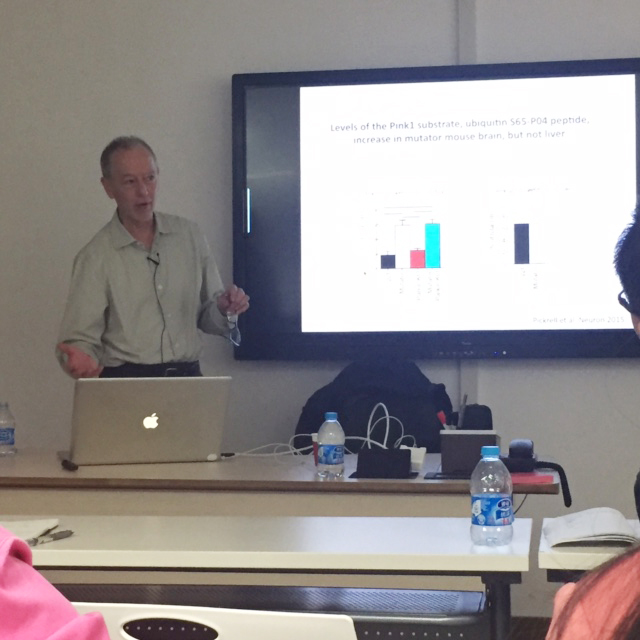In the afternoon of November 6, 2015, Dr. Richard Youle, senior investigator of Biochemistry Section inNINDS, gave a lecture on “Damage control: how PINK1 and Parkin survey mitochondrial fidelity and respond with selective autophagy” as part of ShanghaiTech’s Life Science Seminar Series.
Dr. Youle joined the Surgical Neurology Branch of NINDS in 1985 as a principal investigator where he has developed new treatment strategies for brain tumors. His lab is now exploring the molecular mechanisms ofmitophagy pathway.The products of two genes mutanted in autosomal recessive forms of Parkinson’s disease,PINK1 and Parkin, have been identified to work in the same cell biology pathway that induces autophagy of damaged mitochondria. PINK1 is a kinase that flags damaged mitochondria for removal. It is constitutively degraded by the inner mitochondrial membrane protease PARL and maintained at very low levels in undamaged, healthy mitochondria. When one mitochondrion becomes damaged or accumulated misfolded proteins, PINK1 is no longer imported and degraded, and instead accumulated on the outer mitochondrial membrane bound to the TOM complex. From there PINK1 phosphorylates ubiquitin at serine 65 and also phosphorylates the Parkin UBL domain at serine 65 to activate Parkin E3 ligase activity and recruit Parkin to mitochondria. Activated Parkin ubiquitinates numerous outer mitochondrial membrane proteins. These ubiquitin chains on the outer mitochondrial membrane recruit autophagy adaptor proteins and autophagy machinery to selectively eliminate the damaged mitochondria. Through the genetic knockout of five autophagy receptors,Richard Youleet al. found that tworeceptors, NDP52 and optineurin, are the primary receptors for PINK1- and parkin-mediated mitophagy. p62 and NBR1 are dispensable for parkin-mediated mitophagy.Richard Youleet al. also found thatPINK1 recruits NDP52 and optineurin to mitochondria to activate mitophagy directly, independently of Parkin. This supports a new model in which PINK1-generated phospho-ubiquitin serves as the autophagy signal on mitochondria, and Parkin then acts to amplify this signal. This work also suggests direct and broader roles for ubiquitin phosphorylation in other autophagy pathways. Besides Richard Youle also shared us with the new research progress of his lab on animal models of mitochondrial damage yield synthetic phenotypes with Parkin knock out animals and reveal how thePINK1 /Parkin mitophagy pathway may function in vivo to mitigate Parkinsonism.



